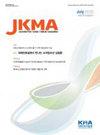哮喘治疗中使用吸入器的原则
IF 0.5
Q3 MEDICINE, GENERAL & INTERNAL
引用次数: 0
摘要
背景:与其他给药途径相比,吸入器治疗起效快、肺疗效好、副作用风险低,是哮喘治疗中最关键的给药途径。当前概念:尽管许多医生和患者认为他们知道如何使用吸入器装置,但大多数人不知道正确的技术。为了达到更好、更有效的治疗效果,吸入装置应适合每位患者的特点和愿望。可用的吸入器装置包括加压计量吸入器、干粉吸入器、软雾吸入器和雾化器。为了改善疾病结果和治疗依从性,建议在选择最合适的设备时,根据每位患者的有意识吸入、吸气流量和手肺协调情况,采用个性化的逐步方法。讨论与结论:使用吸入器的常见问题包括吸气前不能完全呼气,吸气力度不足,吸气后屏气不足。因此,继续教育和支持是必要的,以确保最佳的结果,并使患者改善吸入器的使用技术。卫生保健提供者也应该了解这些设备并开发系统,以便在临床实践中为患者提供全面的支持。本文章由计算机程序翻译,如有差异,请以英文原文为准。
Principles of the use of inhaler devices in asthma treatment
Background: Inhaler therapy is the most critical route of administering drugs in the management of asthma due to its rapid onset of action, better pulmonary efficacy, and reduced risk of side effects, compared with other routes of administration.Current Concepts: Although many physicians and patients believe they know how to use inhaler devices, most do not know the correct techniques. To achieve better and more effective treatment results, the inhalation device should be appropriate for the characteristics and wishes of each patient. Available inhaler devices include pressurized metered dose inhalers, dry powder inhalers, soft mist inhalers, and nebulizers. To improve disease outcomes and treatment adherence, a personalized stepwise approach, based on each patient’s conscious inhalation, inspiratory flow, and hand-lung coordination, is recommended in the selection of the most appropriate device.Discussion and Conclusion: Common problems with inhaler usage include failure to exhale completely before inhaling, insufficient inhalation efforts, and inadequate breath-hold after inhalation. Therefore, continuing education and support are warranted to ensure optimal outcomes and enable patients to improve inhaler usage techniques. Health care providers should also know the devices and develop systems in order to provide comprehensive support to patients in clinical practice.
求助全文
通过发布文献求助,成功后即可免费获取论文全文。
去求助
来源期刊

Journal of The Korean Medical Association
Medicine-General Medicine
CiteScore
0.50
自引率
0.00%
发文量
84
审稿时长
4-8 weeks
期刊介绍:
The Journal of the Korean Medical Association (JKMA) is the official peer-reviewed, open-access, monthly journal of the Korean Medical Association (KMA). It contains articles in Korean or English. Its abbreviated title is ''J Korean Med Assoc''. The aims of the Journal include contributing to the treatment of and preventing diseases of public health importance and to improvement of health and quality of life through sharing the state-of the-art scientific information on medicine by the members of KMA and other national and international societies.
 求助内容:
求助内容: 应助结果提醒方式:
应助结果提醒方式:


